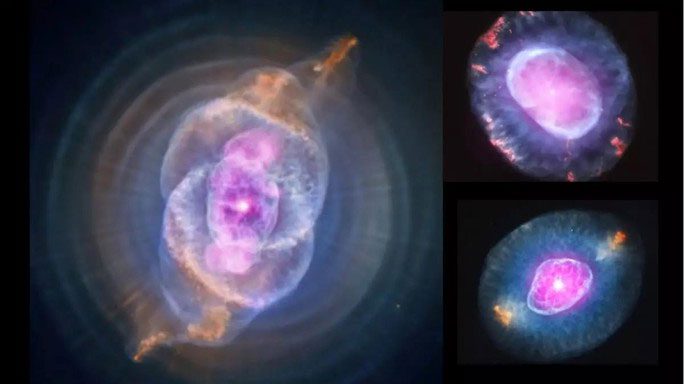PM 1-322 – a cosmic object resembling a ghostly purple-blue eye – gazes directly at Earth. Discovered in 2005, scientists have only recently begun to understand its nature.
According to Space, PM 1-322 is located 6,800 light-years away, initially identified in 2005, showing long-term variations in light and something resembling an outburst.
It has left astronomers puzzled over the years, with many theories proposed and subsequently dismissed.
Recently, by mobilizing a “watchful eye” from various observatories worldwide, a team of scientists led by Dr. Ernst Paunzen from Masaryk University (Czech Republic) has finally found the answer.

Different images of the planetary nebula PM 1-322 – (Photo: NASA/CXC/RIT).
Despite its strange and atypical characteristics, PM 1-322 is still a well-observed object: a planetary nebula.
It also has a companion star, which has been responsible for the interference in the data, causing the light from this nebula to vary oddly and leading scientists astray for 18 years.
Additionally, another reason for the changes in PM 1-322 is that since its discovery, this nebula has continued to evolve, indicating that we are witnessing a moment of its formation.
The term “planetary nebula” is somewhat of a misnomer, but it has been historically used to refer to the “remains” of ancient stars, rather than being created by planets.
Stars – including our Sun in the future – will undergo death in stages: They will flare up into red giant stars, engulfing nearby planets, collapse into white dwarfs, and ultimately explode.
The exploding star – known as a supernova – will eventually leave behind only a “ghost” in the universe, a bright, layered, ethereal halo surrounding the location it once occupied. This is what we refer to as a “planetary nebula.”
Planetary nebulae clearly expose the elements that made up the deceased star. In the universe, each generation of stars forges more complex materials in their cores and releases them back into space upon death, providing material for the next generation of “higher” stars.
Thus, studying these nebulae helps explain how our Solar System – and Earth – formed.
PM 1-322 also offers a glimpse into the future of our own world, as the Sun is expected to explode in a similar manner within the next 5 billion years. The material from the solar nebula will encompass Earth, one of the planets that will be consumed by the Sun during its red giant phase.




















































